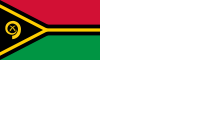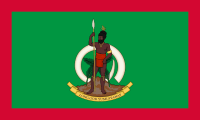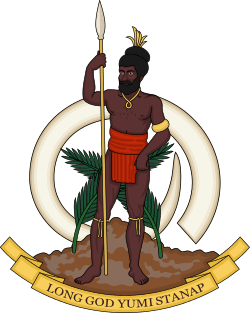Flag of Vanuatu
.svg.png) Flag of Vanuatu | |
| Use |
National flag, civil and state ensign |
|---|---|
| Proportion | 19:36 |
| Adopted | 18 February 1980 |
| Design | A horizontal bicolor of red and green with the black isosceles triangle based on the hoist side bearing the golden boar's tusk encircling two crossed namele fern fronds in the center and the golden pall, a thin yellow narrow horizontal stripe that splits in the shape of the horizontal Y, centered over the partition lines and was edged in black against the red and the green bands while the two points of the Y faces on each corner and encloses the triangle on the hoist-side. |
The flag of Vanuatu was adopted on 18 February 1980.
In 1977 a flag of almost the same colours and symbolism as the future national flag was designed by local artist Kalontas Malon and adopted by the Vanua'aku Pati. When the party led the New Hebrides to independence as Vanuatu in 1980, the colours of the party flag (red, green, black and yellow) were chosen to be the basis for the national flag on Independence Day, July 30, 1980. A parliamentary committee chose the final design based on submissions from local artists.[1]
Symbolism
The green represents the richness of the islands, the red symbolises the blood of wild boars and men, and the black the ni-Vanuatu people. The Prime Minister of Vanuatu, Father Walter Lini, requested the inclusion of yellow and black fimbriations to make the black stand out. The yellow Y-shape represents the light of the gospel going through the pattern of the islands in the Pacific Ocean (approximately 83% of the people of Vanuatu profess Christianity).[1]
The emblem in the black is a boar's tusk — the symbol of prosperity worn as a pendant on the islands — along with two leaves of the local namele tree. These leaves are supposed to be a token of peace, and their 39 leaflets represent the 39 members [sic] of the Parliament of Vanuatu.[1]
Construction
With a flag width of 180 units, the width of the triangle, from hoist to point, should be 84 units. The height of the flag will thus be 95 units, with the yellow band being 5 units tall, the gold fimbriations are each 6 units tall and the upper and lower (red and green) parts of the field are, thus, 39 units tall each.[1]
Other flags of Vanuatu
Subnational flags from Vanuatu
 Flag of Penama Province[2]
Flag of Penama Province[2]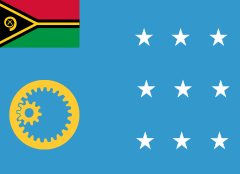 Flag of Sanma Province[3]
Flag of Sanma Province[3] Flag of Shefa Province[4]
Flag of Shefa Province[4]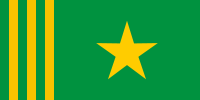

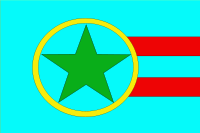
Historical flags of the New Hebrides
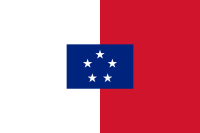
.svg.png)
.svg.png)
.svg.png)
.svg.png)



.svg.png)

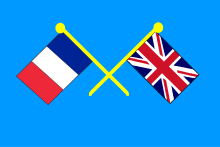
.svg.png)
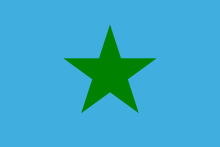 Flag of the ephemeral Republic of Vemerana (1980)[10]
Flag of the ephemeral Republic of Vemerana (1980)[10]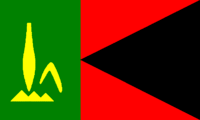 Flag of People's Provisional Government of Vanuatu led by Vanua'aku Pati[8]
Flag of People's Provisional Government of Vanuatu led by Vanua'aku Pati[8]
See also
- Coat of arms of Vanuatu
- Flag of South Africa (adopted 1994) which also closely resembles the flag of Vanuatu
- Flag of Tuva (created 1992) which closely resembles the flag of Vanuatu
References
- 1 2 3 4 5 6 "Vanuatu". Flags of the World. 20 November 2013. Retrieved 2 August 2014.
- ↑ "Penama Province (Vanuatu)". Flags of the World. 13 April 2013. Retrieved 2 August 2014.
- ↑ "Sanma Province (Vanuatu)". Flags of the World. 18 December 2013. Retrieved 2 August 2014.
- ↑ "Shefa Province (Vanuatu)". Flags of the World. 8 July 2006. Retrieved 2 August 2014.
- ↑ "TAFEA Nation (Vanuatu)". Flags of the World. 21 February 2009. Retrieved 2 August 2014.
- ↑ "Nation of Tanna (Vanuatu)". Flags of the World. 20 July 2013. Retrieved 2 August 2014.
- 1 2 3 4 5 6 7 8 "Historical Flags (Vanuatu)". Flags of the World. 10 June 2011. Retrieved 2 August 2014.
- 1 2 "Vanuatu". World Statesmen. 10 June 2013. Retrieved 27 September 2016.
- ↑ postage stamp New Hebrides Condominium 1F featuring 3rd South Pacific Games Port Moresby 1969 dated 1969
- ↑ "State of Vemerana (Vanuatu)". Flags of the World. 14 February 2007. Retrieved 2 August 2014.
Sources
- "Vanuatu". The World Factbook. United States Central Intelligence Agency. 20 June 2014. Retrieved 2 August 2014.

